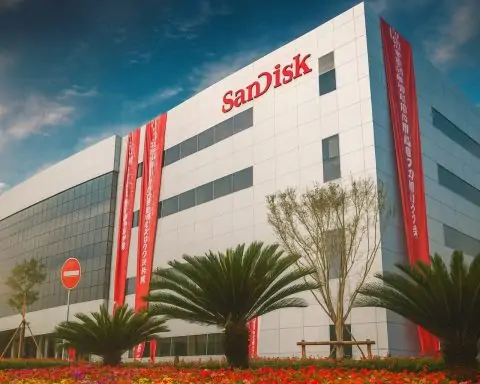- Price & Performance: Sea Limited (NYSE: SE) closed at $163.42 on Oct. 15, 2025, down 9.6% on the day [1]. The stock has rallied sharply in 2025 (near its 52-week high of $199.30) but saw a sharp pullback this week [2] [3]. Its 52-week trading range is roughly $92.50–$199.30 [4].
- Recent Earnings: In Q2 2025 (Apr–Jun), Sea’s revenue jumped 38.2% year-over-year to $5.26 billion, topping estimates [5]. Shopee e-commerce sales grew ~33.7% (to $3.8 billion) [6], and Garena gaming bookings surged (up ~23%) [7]. SeaMoney (digital finance) revenue skyrocketed 70% in Q2 [8], reflecting the firm’s expanding fintech services. CEO Forrest Li noted “all three of our businesses have delivered robust, healthy growth” in this period [9].
- Business Updates: Shopee turned profitable last year (Q3 2024) and continues strong momentum. Garena’s flagship game Free Fire saw paying users and bookings rise in Q2 [10]. SeaMoney – recently rebranded Monee – is focusing on digital banking and payments [11], with new headquarters opened in Singapore (May 2025) to accelerate fintech growth.
- Analyst Ratings: Wall Street is broadly bullish. The consensus rating is a Moderate Buy (about 2 Strong Buy, 9 Buy, 6 Hold) with an average 12-month price target around $177 [12]. JPMorgan analysts raised their target to $230 (Overweight) in Sept., citing Shopee’s improving monetization and lower logistics costs [13] [14]. Zacks recently upgraded SE to a “Strong Buy” [15], while BofA (Neutral) bumped its target to $206 on higher sales commissions [16]. (Some outfits remain cautious: Arete Research cut its rating to “Neutral” with a $177 target [17].)
- Upcoming Catalysts: Sea will report Q3 results around Nov. 11, 2025 [18]. Analysts expect continued double-digit revenue growth, though high earnings estimates (EPS >+100% yoy for the quarter) have been flagged [19]. Key near-term drivers include Southeast Asia’s holiday shopping season, shifts in Shopee’s marketing spend, and any further gains in Garena’s gaming user base.
Stock Snapshot: Recent Price Action
After a strong 2025 rally, Sea’s stock has been volatile this week. The shares opened Oct. 15 near $184 (after closing $180.69 on Oct. 14) but slumped to a day’s low of about $162, settling at $163.42 [20]. This ~10% one-day drop wiped out weeks of gains, in line with a broader tech selloff. Trading volume on Oct. 15 (~9.16 million shares) far exceeded recent averages [21]. Over the past 52 weeks, SE stock traded between $92.50 and $199.30 [22], so even after this pullback the shares remain well above early-year lows.
Market watchers point out the stock’s valuation is now stretched – at ~94x trailing EPS [23] – so even modest profit expectations are fully baked in. As of Oct. 15, institutional ownership was about 59.5% [24], implying a lot of buy-side interest. Technical levels are notable: the stock briefly pierced its 52-week high in early Oct (near $199) before easing. Many traders will watch if $160 holds as near-term support, while analysts debate if the pullback is a buying opportunity.
Shopee, Garena & SeaMoney: Strong Business Momentum
Sea’s three core businesses – Shopee e-commerce, Garena gaming, and SeaMoney fintech – have all been firing on cylinders, fueling the recent stock rally. In the latest quarterly results (Q2 2025, announced Aug. 12), e-commerce sales jumped sharply. Shopee revenue grew 33.7% year-over-year to $3.8 billion [25], driven by heavy buying ahead of holidays. CEO Forrest Li remarked that Shopee is adopting social features and competitive pricing to boost user engagement [26] [27]. Notably, Shopee (in Asia and Brazil) reached sustained profitability by Q3 2024 and has reported positive core profits since [28]. In Q2, management guided that Shopee’s annual GMV growth should comfortably exceed their 20% target [29].
The gaming arm, Garena, also saw robust demand. Q2 game bookings (aggregate customer spend) rose ~23% and paying users rose 17.8% [30]. Garena’s hit title Free Fire remains popular across Latin America and Southeast Asia, and Li noted bookings now project “more than 30% growth this year” [31]. Gaming revenue (digital entertainment segment) grew 28.4% to $559.1 million in Q2 [32]. Analysts highlight that Garena’s strong recovery from the pandemic-driven dip continues to underpin Sea’s profits.
Sea’s digital financial services (formerly SeaMoney) is expanding rapidly. In Q2, fintech revenue soared 70% year-over-year to $882.8 million [33], even outpacing the e-commerce growth rate. This was on top of a 58% rise in Q1 revenue [34]. SeaMoney (now branded Monee) offers mobile wallets, payments, consumer loans and insurance, often integrated with Shopee. Management is investing in regional payment infrastructure – in May 2025 it opened a flagship Singapore HQ for Monee [35]. The government even praised Sea for building fintech “centers of excellence” in Singapore [36].
In sum, Forrest Li says “all three of our businesses have delivered robust, healthy growth”, giving him confidence “of delivering another great year” [37]. He adds Sea is at a stage where it can “pursue growth opportunities while improving profitability.” This narrative – growing top line with improving margins – has been key to the rally.
Analysts’ Ratings & Views
Wall Street’s recent commentary on SE has been upbeat on growth but mixed on valuation. As of mid-October, the analyst consensus stands at a “Moderate Buy” (per MarketBeat), with an average 12-month price target around $177 [38]. In practice, most analysts are bullish: MarketBeat notes 2 Strong-Buy, 9 Buy and 6 Hold ratings on SE [39].
Notable recent moves include JPMorgan’s upgrade. On Sept. 11, JPM analyst Ranjan Sharma reiterated an Overweight rating and lifted the price target from $208 to $230 [40], citing Shopee’s accelerating monetization. An investing.com summary reports JPMorgan saying that industry improvements “should allow Shopee to unlock advertising revenues and benefit from reduced logistics costs” [41]. The firm also pointed out that Sea’s vast user base and growing cash flows give it strategic optionality. Similarly, BofA Securities kept Sea at Neutral but modestly raised its 2026–27 forecasts. BofA’s analysts noted a recent spike in sales commissions and observed that Sea’s EPS held up even as it offered discounts, resulting in a price objective bump from $200 to $206 [42].
Other brokerages have also raised targets on recent results: for example, Barclays lifted its target to $214 (Overweight) in mid-August, and Singapore banks like DBS and Maybank set targets in the $238–$241 range (both on Buy ratings) in mid-Sept [43]. (By contrast, some caution is creeping in: Arete Research cut SE to “Neutral” with a $177 target on Sept. 3 [44], and a few analysts have trimmed profit estimates given aggressive marketing spending.) Overall, the analyst street acknowledges Sea’s powerful growth story but flags the high valuation: one note observes that the stock is “up an impressive 72.3% year-to-date” but “remains fairly valued” against the expected profit surge [45].
Aside from ratings, recent technical and sentiment signals turned mixed. After Friday’s drop, short-interest metrics might rise, though specific hedge-fund moves are not widely reported. MarketBeat notes small institutional filings in mid-Oct (e.g. Equitable Trust disclosed a $23M stake [46]), but these are routine. The heavy share of ownership by large holders (~60% in hedge/institutional hands [47]) suggests significant buy-side conviction remains.
Earnings & Near-Term Outlook
Investors are now bracing for Sea’s next earnings (Q3’25, expected Nov. 11 [48]) to see if the momentum holds. FactSet consensus forecasts have been high: for example, analysts expect roughly 100%+ EPS growth for the quarter (around $1.10–$1.15 vs. prior year) on continued revenue gains. However, any hint of weaker-than-expected guidance could put further pressure on the stock, given its current premium.
In their modeling, analysts incorporate Shopee’s gradual move to higher take-rates (as noted by JPMorgan) and steady growth in SeaMoney and gaming. Some are already baking in modest deceleration after such strong prior quarters. Notably, Bloomberg Intelligence has estimated Sea’s net income could roughly quadruple by end-2025 based on these trends (though its exact forecasts are proprietary).
Looking ahead, most strategists see Sea’s core fundamentals intact: Southeast Asia’s internet adoption remains on an upward trajectory, and Sea’s diversified model (e-commerce + fintech + gaming) provides multiple growth levers. For example, one Wall Street note points out that despite the recent stock pullback, the “profitability flywheel” across segments is accelerating [49] [50]. Yet they caution that with the share price near record levels, much of that good news is already priced in. Any market turbulence (e.g. U.S.-China trade tensions or broad tech selloffs) could trigger more volatility in SE.
In summary, Sea’s near-term outlook is a mix of optimism and caution. On one hand, analysts highlight robust top-line momentum: Shopee’s profitability and growing order volume, Garena’s recovering bookings, and SeaMoney’s rapid expansion could drive another strong quarter [51] [52]. On the other hand, the stock trades at a stretched P/E (>90x) and faces rising competition (TikTok Shop, Lazada are raising fees aggressively) and rising marketing costs. As JPMorgan noted, higher marketplace fees across ASEAN are a “positive momentum” for SEA’s business model [53], but how long that offsets spending is an open question.
Bottom line: Sea’s business continues to hum, but this week’s share price drop shows that investors are watching for signs of softness. “We expect Shopee to remain profitable going forward,” as Forrest Li said, which should underpin long-term value [54]. Still, near-term gains may be limited by valuation and risk sentiment. For now, analysts generally retain a buy-rated stance (avg. PT ~$177), even as they monitor macro headwinds. The coming weeks – ahead of the Nov. 11 earnings – will likely see Sea’s stock trading on any fresh cues about consumer demand, cost controls, and regional competition.
Sources: Company filings and earnings releases; Reuters (Asia-Pacific) market coverage [55] [56]; stock data from Reuters [57]; analyst reports (via MarketBeat, Investing.com, InsiderMonkey) [58] [59] [60]; industry press (Asian Banking & Finance) [61]. All data current as of Oct. 15, 2025.
References
1. www.reuters.com, 2. www.reuters.com, 3. www.reuters.com, 4. www.reuters.com, 5. www.reuters.com, 6. www.reuters.com, 7. www.reuters.com, 8. www.reuters.com, 9. www.reuters.com, 10. www.reuters.com, 11. asianbankingandfinance.net, 12. www.marketbeat.com, 13. www.investing.com, 14. www.investing.com, 15. www.marketbeat.com, 16. www.insidermonkey.com, 17. www.marketbeat.com, 18. stockanalysis.com, 19. www.marketbeat.com, 20. www.reuters.com, 21. www.reuters.com, 22. www.reuters.com, 23. www.reuters.com, 24. www.marketbeat.com, 25. www.reuters.com, 26. www.reuters.com, 27. www.reuters.com, 28. www.reuters.com, 29. www.reuters.com, 30. www.reuters.com, 31. www.reuters.com, 32. www.reuters.com, 33. www.reuters.com, 34. www.reuters.com, 35. asianbankingandfinance.net, 36. asianbankingandfinance.net, 37. www.reuters.com, 38. www.marketbeat.com, 39. www.marketbeat.com, 40. www.investing.com, 41. www.investing.com, 42. www.insidermonkey.com, 43. www.marketbeat.com, 44. www.marketbeat.com, 45. www.marketbeat.com, 46. www.marketbeat.com, 47. www.marketbeat.com, 48. stockanalysis.com, 49. stockanalysis.com, 50. www.marketbeat.com, 51. www.reuters.com, 52. www.reuters.com, 53. www.investing.com, 54. www.reuters.com, 55. www.reuters.com, 56. www.reuters.com, 57. www.reuters.com, 58. www.marketbeat.com, 59. www.investing.com, 60. www.insidermonkey.com, 61. asianbankingandfinance.net










